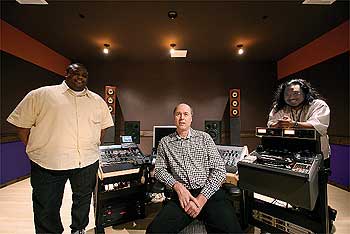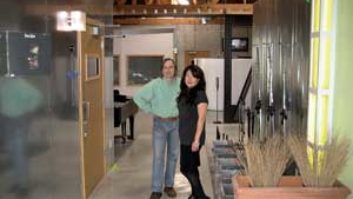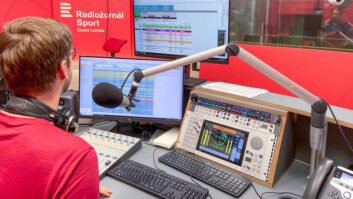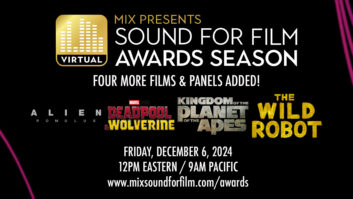
From left, in Universal Mastering West, Mastering B, are quality-control specialist Charles Cosin, UMB senior VP of Studio and Vault Operations Paul West and studio designer/acoustician Hanson Hsu
Photo: Isabelle Shu
For years, as I made the daily commute from Studio City to Hollywood through the Cahuenga Pass, I drove past the iconic mid-century building that housed Hanna-Barbera Studios. But The Flintstones and Jetsons are long gone; in their place are the engineers of Universal Mastering Studios West, one of three mastering studios in the States owned and operated by the Universal Music Group; the others are in Santa Monica and Manhattan.
UMSW took over the premises following construction of a seven-room state-of-the-art facility inside what was formerly a warehouse space. The turnkey project was designed and overseen by Hanson Hsu’s Delta H Design Inc., employing the firm’s trademarked ZR (which stands for zero reflection) Acoustics®, a sophisticated technology that eliminates the need for trapezoidal architecture while using everyday materials. Indeed, each of the seven spaces — two mastering rooms and five production rooms — is strictly rectangular, and four of the production rooms are no bigger than the walk-in closet of a Beverly Hills debutante.
The facility was installed within the existing building in a “doughnut hole” arrangement, with hallways separating and surrounding the exterior of the newly built structure from the interior walls of the surrounding building. It looks conventional, but it sounds incredible, even though the rooms have yet to be totally tweaked out in terms of gear and placement. You don’t have to take my word for it — just ask the guys who work in these rooms.
“I love the way the room sounds; it’s totally transparent,” says senior mastering engineer Erick Labsen, taking a quick break from a session in Mastering B. “The room is very revealing; I’m really happy with the way things sound in here, and then, when I take them out and listen to them on other systems, they sound great, as well. When Hanson showed me how it works, I thought, ‘Why hasn’t anyone thought of this before?’ He’s come up with something that’s groundbreaking in room design. From a physics and math point of view, I think it’s absolutely brilliant.”
“When Hanson showed us how ZR works, our jaws dropped,” says senior mastering/mixing engineer Pete Doell. “It really sounds like such an obvious thing in a way. But on another level, it’s like from Mars. You can stand in the corner and the bass doesn’t build up, and you can hear everything coming out of both speakers. It’s a good thing not only for the mastering engineer, but for the client.”
According to UMG’s senior VP of Studio & Vault Operations, Paul West, Hsu’s nontraditional proposal was attractive because it met the studio’s “eclectic” needs. “The idea of building small rooms for production, mid-sized rooms for editing and some mastering and larger rooms with mixing and mastering capabilities — all being of the same acoustic signature and design — was the key for making that decision,” West explains.
“I didn’t believe it till I heard it,” says quality-control specialist Charles Cosin, who works in P4, one of the compact production rooms. At Hsu’s suggestion, I’ve brought three CDs from my current listening stack, and Cosin gives me his chair for a quick playback session. I start with “Come Together” from the remastered Abbey Road, then “1901” from Phoenix’s Wolfgang Amadeus Phoenix and finally “Dear God” from Monsters of Folk’s self-titled debut. None of them has ever sounded clearer, fuller or more enveloping to my ears. I turned to Hsu, and asked, “Can you do my family room?”
“Look at this playback system — it’s simple and clean,” Hsu says. “A Hafler amp, Dynaudio BM 15s with passive crossover and stock cables. And you’re hearing it the short way in a rectangular room. You can clearly pick up minute details in the content, like being able to hear the difference between 96k/24-bit files and 44.1k/16-bit files.”
We head next door to P3, the bigger production room, where senior engineer/R&D specialist Ed Abbott does his thing. When I play the same three tracks through monitors Abbott designed for Dynaudio, the sound becomes downright 3-D.
Hsu takes me to the conference room, where I sign a nondisclosure agreement and he unrolls the ZR Acoustics blueprints for the job, making me privy to his secret recipe, which I am not at liberty to disclose; otherwise, he’ll have to kill me. All I can say is it’s insanely clever and so simple in principle. Smart guy, that Hanson Hsu.
“Every time we do a new generation of ZR, it improves exponentially,” Hsu points out. “And we’re always discovering new things. For example, Pete Doell discovered while changing speaker cables that you get clear stereo imaging standing behind the speakers. I think I know why that happens, but I’m still working out the science on it.”
On Friday, Abbott and the UMG engineers will bring their ears to B, where they’ll demo a pair of Lipinski Sound L-707s matched with dual subwoofers, which Abbott believes will be the optimum monitor configuration for the room. At the moment, there’s an Audire Otez amp driving a variety of demo speakers, such as Dynaudio C3s and BM 15s, B&W 808s and the currently hooked-up Tannoy 215s.
“The room is big enough that I doubt one sub will cut it,” Abbott says of the need for two subwoofers. “Besides, the ZR math was worked out for stereo speakers, so trying to position one sub would be an exercise in compromise I’m not sure we’d be able to solve satisfactorily — although it might be worth the price of admission to watch Hanson melt down trying to figure it out.”
Abbott goes back to work in P3 and Hsu heads off to a meeting with studio manager Nick Dofflemyer, leaving me in B for some solo playtime. I slip in Abbey Road, crank up the volume and blast the second half through the Tannoys. Wow. If they go with the Lipinskis, I’ll be glad to take the Tannoys off their hands and put them in my ZR Acoustics family room. Hey, I can dream, can’t I?
Send L.A. news to Bud Scoppa at
bs7777@aol.com





